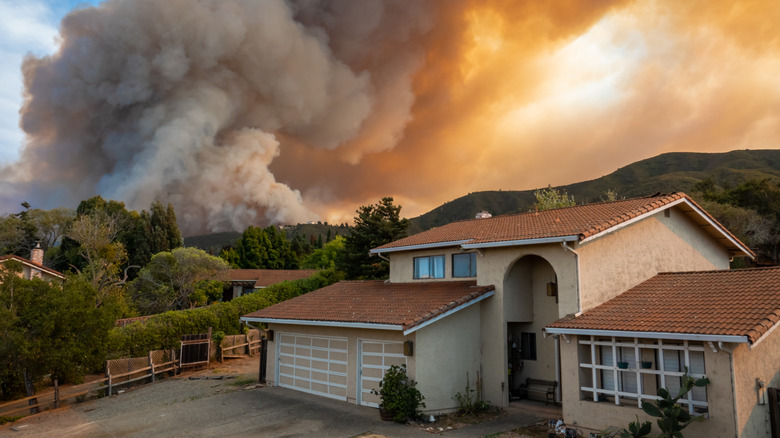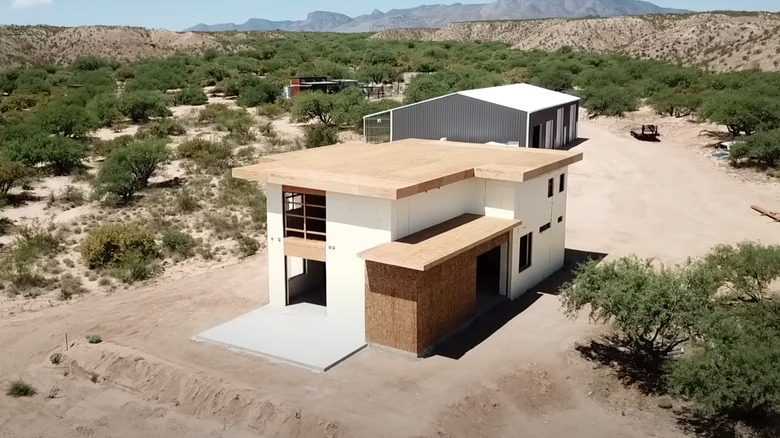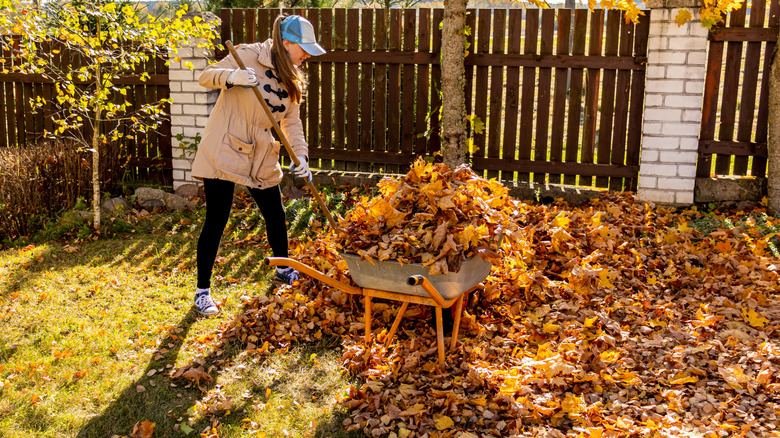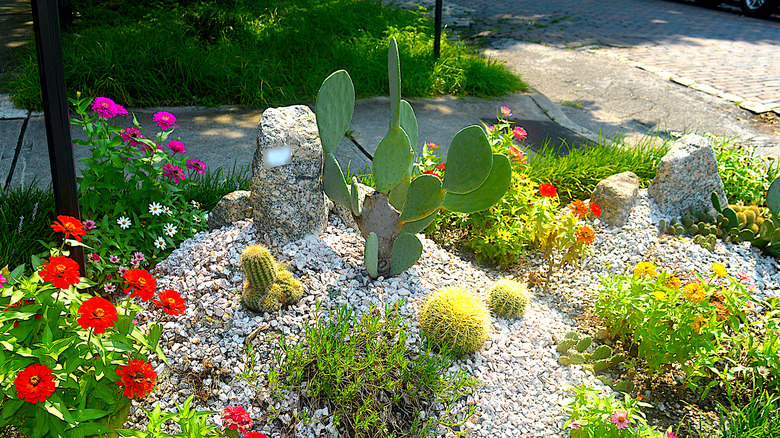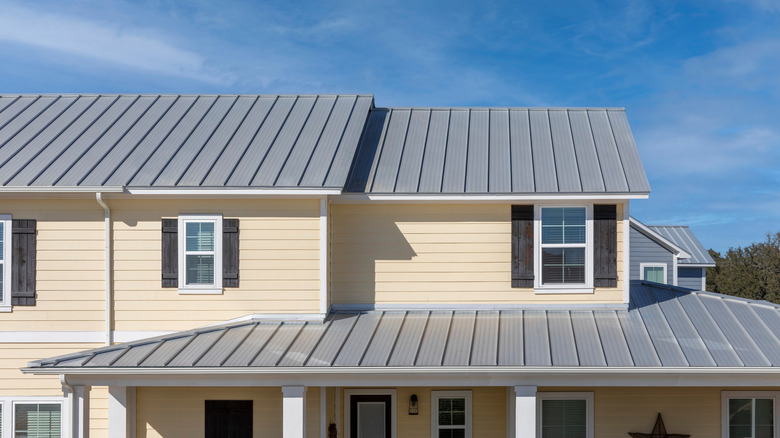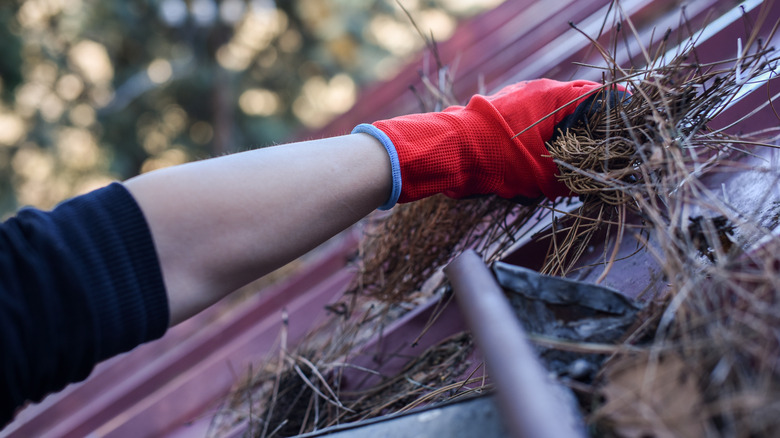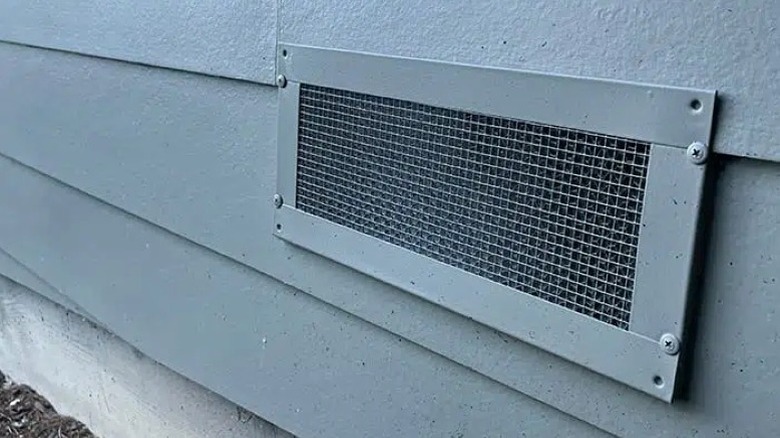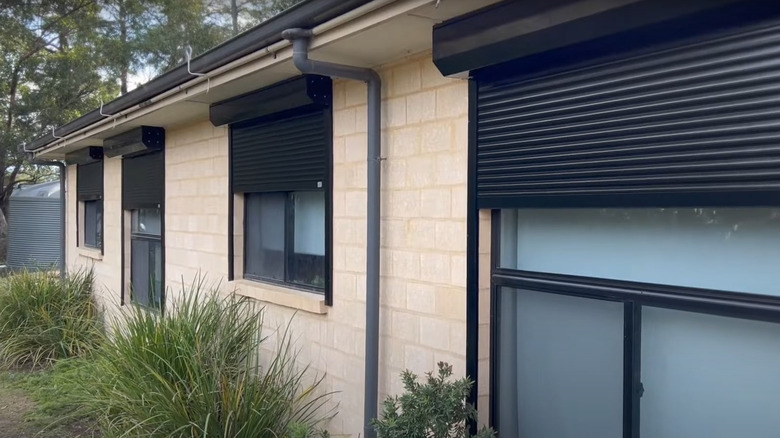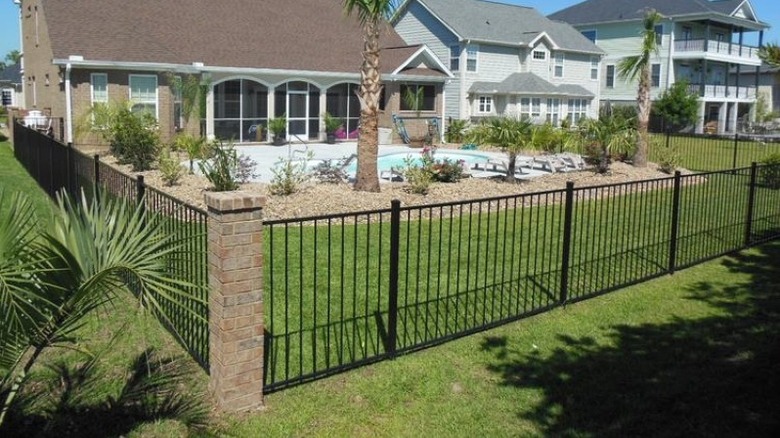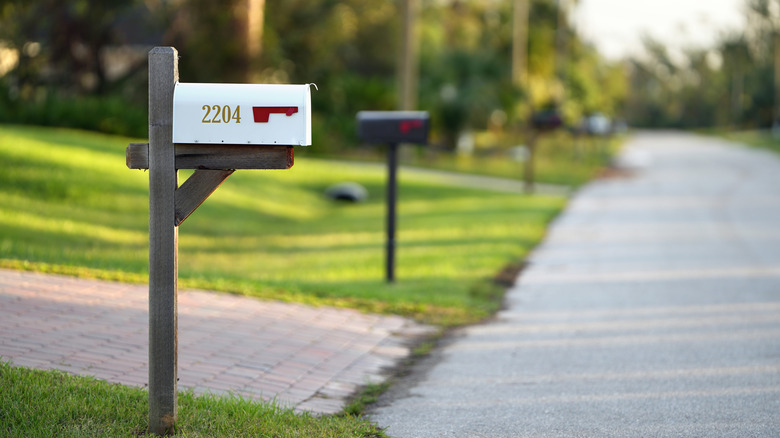Ways To Help Protect Your Home Against Fires
We may receive a commission on purchases made from links.
Wildfires are a prevalent risk throughout the United States. It only takes a couple of seconds for a wildfire to erupt and quickly spiral out of control, especially during dry seasons and summers. Most people understandably rely on firefighters to swoop in and save them and their homes, but there are some helpful preparations you can do ahead of time. Being proactive and fireproofing your own home makes it easier for professionals to assist you when an emergency arises.
To help you better safeguard your home and yard from fire, House Digest conducted an exclusive interview with Fire Chief Michael Swanson, who shared actionable advice for homeowners. Some preventative strategies require money upfront since fire-resistant materials and barriers aren't cheap. However, people on a budget can significantly increase fire safety through simple, affordable measures like clearing away yard debris and choosing the right plants and mulching. These are merely two examples of ways you can better your chances of saving your home without investing in a whole new setup.
One of the most important things to have is proper diligence and knowledge when it comes to maintaining your property. Plus, the better protected your home is, the easier it is to get homeowners insurance coverage in the case of wildfire damage. Read on to learn how to keep your house — and your household members — safe with the following fire-protection methods.
Build room additions and exterior buildings with insulated concrete forms
A fireproof foundation is key to constructing a fireproof home. If you're having a new house built from scratch, installing room additions, or erecting exterior buildings on your property, an easy but crucial way to fireproof your home is to start with insulated concrete formwork (ICF). ICF is a modern and innovative construction method that utilizes insulated blocks filled with concrete. Completed buildings are incredibly insulated and have lower energy costs, muffle sound, resist mold and pests, and have a four-hour fire rating. The fire rating is impressive, as the top ICF materials didn't weaken after four hours of exposure to 2,000-degree Fahrenheit temperatures. This is owed to the simple fact that concrete does not burn.
The reliability and safety of ICF doesn't come without a price. It is estimated that it costs about 15% to 20% more than traditional foundation methods. In the United States, it costs about $18.25 to $31.75 per square foot, which is materially more expensive compared to the average $9 to $15 per square foot cost for standard blocks. However, if you decide to use ICF, keep in mind that the initial cost may pay for itself. The fire-resistance ratings alone could save your home during an emergency, and the increased energy efficiency will trigger savings over time in heating and cooling costs. ICF contractors, distributors, and engineers are located throughout the United States. Use ICF Hub's Insulated Concrete Forms Directory to find local companies, and compare different ICF products by checking out The Insulating Concrete Forms Magazine's ICF Comparison Chart.
Clean up the landscape surrounding your home
You don't have to dish out thousands of dollars to make your home safer from wildfires. Creating a "defensible space" zone is a fire control practice where people actively keep their houses and properties as low-risk as possible. The idea is to keep flammable and combustible yard waste outside of a 30-foot radius of your home. Find ways to landscape your yard on a budget and maintain your lawn to keep it from becoming its own fire hazard. Eustis Fire Department Chief Michael Swanson exclusively tells House Digest that along with protecting your own property, defensible space "is also about being a good neighbor. You're protecting your neighbors by giving firefighters more space to protect homes efficiently."
Start maintaining your lawn by removing weeds and fallen leaves from grass and walking paths. You should also avoid using invasive and highly flammable grass around your home, like buffelgrass and cheatgrass. Keep trees trimmed and at least 10 feet away from each other so it's harder for embers to travel between them. Follow similar guidelines when placing playground equipment and garden structures to reduce their flammability. Ensure you maintain gardens, grass, and trees throughout the year. If you don't clean up during the spring, vegetation and yard debris can quickly pile up and become overgrown, creating a real fire hazard during wildfire season.
If you have acres of property, avoid storing items in the cover of trees. Chief Swanson warns, "Another issue we see on larger properties is people hiding things in the woods. They keep their ATVs, boats, and things under trees for the shade. It keeps them out of the sun, but you should move them during brush fire season. Otherwise, they'll become fuel for the fire."
Revamp your garden with bushes and trees that are less prone to catching fire
Keeping your yard and garden well maintained is only one step in protecting your home against fires. Some plants are more susceptible to fires than others and quickly become engulfed in flames. Evergreen trees and shrubs have living leaves throughout the year and retain less moisture than deciduous plants, making them far more vulnerable to catching alight. Height is also a determining factor for flammability. Bushy shrubs and low-hanging trees have leaves that are close to the ground. When a fire spreads across the grass, it more easily ignites those lower leaves and can take over an entire tree.
Deciduous plants are often a better choice for a fire-wise landscape, since they retain more moisture and don't have leaves during part of the year. However, many other factors also determine flammability. Choose trees that have sparser branches or wide and flat leaves. Minimize the number of plants with dense foliage, tiny leaves, and pine needles, which burn much easier. Some of the best plants to have in your yard if you live in a fire-prone region include things like succulents (both small ornamental species and larger ones like yucca and agave) and lush, moisture-loving shrubs like hydrangeas, camellias, and philodendrons.
Also, when laying out your garden, don't place plants and or wood chips right up against your home. Chief Swanson explains, "People like to lay mulch up against their home's siding, but what they need to do is put a foot or two of rock. Or anything non-combustible." He also points us toward the Florida Department of Agriculture and Consumer Services' List of Less-Flammable Trees and Shrubs, which provides a basic overview of the plant species you should and shouldn't grow in your yard.
Renovate your roof with fire-resistant materials
One of the biggest home improvement projects is a roof renovation. These are only necessary once every two to five decades, but if your roof is due for a revamp, going the fire-resistant route may be worth it. In order to pick the best roof for your home, you must consider its material, durability, weather resistance, and fire rating. Fire departments and forestry services generally advise against vinyl, because even if it doesn't catch on fire, it doesn't necessarily withstand the flames. Swanson tells us, "The main issue with vinyl is the loss of integrity before ignition. Most [naturally fire-resistant] materials lose integrity at over 450 degrees. Vinyl loses integrity at around 200 to 300 degrees. It might not catch fire, but it will melt, fall out of place, and expose attic space."
For roofing, look for materials listed as non-combustible and as having Class A fire resistance, which indicates they have the most protection against flames. However, many materials may be classified as Class A, but with the tagline "by assembly." This means they require additional materials to be installed underneath the roof to meet that Class A rating.
The roof material itself isn't the only thing that matters. The entire roofing system should be fire-resistant, including the underlayment, deck, insulation, flashing, soffit, and ventilation features. You also want to pick a simple design for your roof. A less complex design is cheaper, faster, uses fewer materials, and is a better bulwark against wildfires. The fewer corners and divots in your roof, the fewer places for yard debris and embers to get trapped. You should also avoid adding permanent rooftop decorations. Cupolas, weathervanes, roof windows, and skylights add gorgeous curb appeal and improve natural light indoors, but may impede a Class A rating.
Clean your gutters as needed throughout the year
A fire-rated roof is only resilient against wildfires if you keep up with exterior maintenance. Look after the gutter system surrounding your roof, and clear out fallen leaves and natural debris as it builds up. These materials are just as ignitable on a roof as they are on the ground. In addition to being fuel for fires, clogged gutters also cause water buildup that damages siding, roofing, and your home's foundation. Ironically, the reservoirs of moisture aren't going to serve as an extra barrier against fires. Instead, the water causes construction materials to crack, grow mold and mildew, and break down, weakening the overall house structure. If the foundation, roofing, and supports are already deteriorating, a house won't last against a wildfire.
Inspect gutters at least twice a year, around early spring and fall. If trees surround your home and you get heavy rain from time to time, inspect them even more often. Clean them when you notice debris building up. There's no exact routine that applies to all homeowners; gutters must be cleaned as needed. You can keep leaves from piling up as quickly by installing gutter guards around your roof perimeter. Amerimax Home Products Lock-In Gutter Guard is a good budget-friendly option, but if you're looking for a top-rated installation, go with something like the Raptor Gutter Guard Contractor Grade Stainless Steel Micro-Mesh Kit. However, keep in mind that roofing experts often advise against guards since debris still accumulates inside the gutters and on the roof, but homeowners become less diligent in cleaning since they expect them to act as impenetrable shields. Because of this, make sure to still routinely clean out your gutters, even if you have these aids.
Install fire-resistant screens over all exterior vents
Vents are an essential modern house feature. These small grates are designed to help circulate indoor air and reduce humidity, and are found on and under roofs, in siding, and on lower foundations. These installations are necessary for keeping a house in good shape, but also create vulnerabilities for fires. Embers from wildfires can drift inside these vents, igniting a home from the inside. Fortunately, this is an easily recognized and fixable fire risk. All you need to do is choose a fire-resistant metal like copper or steel. Don't use fiberglass or plastic materials.
The recommended design depends on where your vent is situated, but most vent manufacturers use a combination of baffles, louvers, and wire mesh. Wire mesh designs should have screens with holes between 1/8 and 1/16 inches to ensure even small embers can't pass through. The State Fire Marshal of California approved several models from the brands Brandgaurd, Embers Out, and Vulcan Vents to use in buildings that require fire resistance. Once the screens are installed, remember to check on them periodically. Like other exterior house features, they can become clogged if not cleaned regularly.
Replace old windows with fire-rated glass
Windows are another house feature that is vulnerable to fires. The glass panes are the main issue, since extreme heat causes them to shatter. Double-pane windows made of tempered glass are your best bet. These installations aren't fireproof, but stand a better chance than traditional single-pane windows. Double-pane windows weren't the standard until the 1970s and 1980s, so many older homes still have just single-panes. Swapping out older styles for double-glazed options with an interlayer of plastic (the interlayer keeps the glass in place even if it cracks) could greatly help to protect your home.
However, the best window framing for fires is up for debate. The overwhelming conclusion is that the glass is more vulnerable than any framing, whether aluminum, vinyl, or wood. However, aluminum is the most fire-safe option, whereas wood and vinyl burn easily. If you have vinyl framing, make sure it is certified and includes a reinforcement bar that somewhat resists high heat. But in short, the main priority should be the glass, not the framing around it.
Window installations are one of the home renovations that require a permit, and installation prices range based on quantity and size. If you don't have the budget, you should avoid DIY home window installations and install window fire screens. These exterior features are larger versions of vent screens, often made of metal, and have a 1/16-inch wire meshing.
Replace flammable fences with non-flammable materials
White picket fences are often associated with the American dream, but all glamorization aside, these classic home additions scream fire risk. Central Marin Fire Department Battalion Chief Todd Lando told USA Today, "Between 60% and 90% of home ignitions start within 5 feet of the home." Fences within 5 feet, or connected to a house, could be a source of ignition, and can also be a means of spreading fires between houses, even if they are situated far apart. When building a fence line, keep it at a far distance or choose less-flammable materials that are less likely to carry a direct line of fire to your home.
Authentic wood fencing is the most flammable type out there, while brick, stone, and metal materials are the safest options. Composite and vinyl fencing aren't as flammable as wood, but can still ignite. If you already have a composite, wood, or vinyl fence that connects to your house, improve fire safety by replacing the closest portions with brick, stone, or metal. Painting or staining a combustible fence with fire-retardant coatings is a good temporary solution, but it won't hold up long-term.
Make your home address and driveway easily visible from the street
When a wildfire is blazing nearby, it's essential that emergency services know where to go. It's easier for fire chiefs and their teams of firefighters to save homes and control fires when they can clearly communicate locations to each other. Street signs should be visible at all intersections, and firefighters should be able to see addresses from the roads. Unreadable or missing street signs may seem out of your control, but you can file a report with your local city.
Make your address visible by putting large numbers on your mailbox and house, and ensure there are no trees or tall bushes blocking these numbers, which goes hand-in-hand with maintaining your landscape. Use a reflective sign with contrasting colors to guarantee they're visible in headlights and from far away. The numbers on your house should be at least 4 inches high if you're 50 feet or less from the road. Increase the height of the numbers the farther back from the road your house is. Property owners are also responsible for their own driveways. Make sure the way to your driveway is easy to see from the street and that it's in decent enough condition to drive on. Chief Swanson also advises gated properties to "make sure the gate is unlocked and open so firefighters can access your property."
